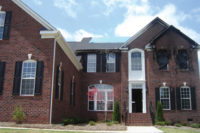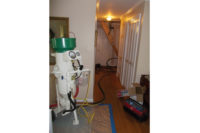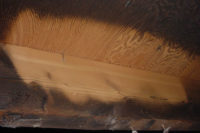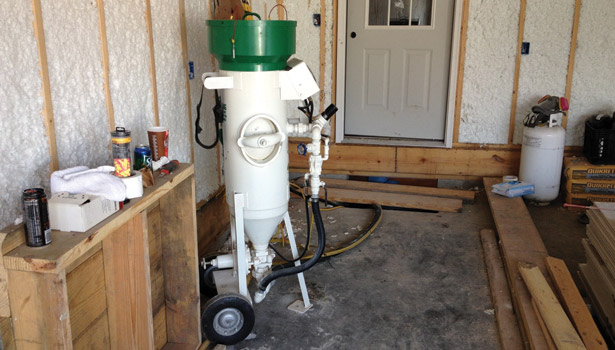Soda Blasting Helps Create New Home for Wounded Warrior














Fair warning - this article is being written on December 7th - a day president Franklin Roosevelt declared “…which will live in infamy.” It will forever be a day of remembrance in this great country. A historical date - eclipsed only by the more recent September 11th attacks that, to many Americans, is one that we’ve promised never to forget. This article, of course, is about architectural restoration, the restoration of a home that itself is a monument. According to a carved stone monument in the front yard it’s “… a reminder of all who have paid the ultimate sacrifice and to all service members that all Americans are forever grateful for your devotion, commitment, and sacrifice that you make to keep our country safe.”
The home at the heart of this case study is not a large or elaborate house. In fact, it’s a fairly simple home, conspicuously newer than all of the others in the older, yet homey residential neighborhood in Kokomo, IN. It’s the story behind this newly constructed home that is most interesting. First consider that this home is being built by the Homes for Wounded Warriors Program (HWWP). Most of the materials and manpower for this building have been donated by local businesses and the local community as a way to remember and repay a debt to our country’s true heroes. Construction of this special home has been underway since the demolition of the previous, dilapidated structure on this site in late August 2012.
This is the new home for a wounded warrior and a true American hero – Specialist Anthony Walton. SPC Walton is a husband, a father of three young children, and, until recently, an infantryman and field radio operator deployed to Afghanistan with the U.S. Army. While on patrol in the Helmand province, his unit was ambushed. As is often the case, the radioman was the focus of much of the enemy fire. SPC Walton can be thankful for his helmet and body armor, as they absorbed most of the deadly impact. Even though he was left alive, SPC Walton was badly wounded, receiving over 37 bullet wounds, many to his left arm. Even following multiple surgeries and constant physical therapy, his left arm is unusable. He is also left with blurred vision to the point of near blindness, severe anxiety disorder, PTSD and insomnia.
With his release from the military, returning home with his family would normally seem like a blessing. However, SPC Walton and his family bore the overwhelming burden that their house was uninhabitable. They literally had nowhere to go. Vacant for years due to its condition, the home’s foundation was inadequate and unsafe. The floors were sagging and the roof leaked. The heating system was non-functional. The house was full of moisture with the accompanying mold and mildew. With his looming medical retirement, the physical challenge of his wounds, and the inevitable drastic reduction in income, times were about to become even more challenging for SPC Walton and his small family. That is until Specialist Walton was selected by a committee for the Homes for Wounded Warriors Program.
In late August 2012, the uninhabitable home, shaky foundation and all, was cleared to make way for the new SPC Anthony Walton home. Demolition complete, construction was proceeding at a brisk pace, with a constant flow of contractors – all volunteers, or paid with donations – into and out of the quickly rising building. Suddenly things came to an immediate halt. For those of us in the restoration industry, the details are going to sound fairly familiar. A plumber doing work in the crawlspace reported extreme moisture along with actively growing mold. The extent of the mold – “black mold” throughout the entire crawlspace – was alarming. Even more alarming was the fact that this was a new house being constructed on a new foundation. A perfect storm of rain, improper drainage and a very aggressive build schedule trapped a great deal of water inside the structure’s sub-floor and crawlspace leading to the mold problem.
Mold contamination is a serious threat to the health and well-being of indoor air quality and the residents that are exposed to it. Troy Mercer, Project Manager for the Homes for Wounded Warriors Program – himself a decorated combat squad leader, a medically retired wounded veteran with over 14 years service, including combat in operations Desert Storm and Iraqi Freedom, as well as deployment in Afghanistan - understood this. Being a volunteer didn’t lessen Troy’s understanding that the mold was a serious problem. Nor did it lessen his negative reaction to the suggestions by most of the contractors on the job. They recommended spraying the entire crawlspace with bleach, or other chemicals. He knew in his gut that this was the wrong approach. Not only were the chemicals potentially dangerous, they didn’t really address the issue of removing the mold and its toxicity. Furthermore, every one of the “experts” on-site that seemed to think spraying chemicals was the answer was reluctant even to go into the crawlspace to investigate, let alone be the one to spray up to 55 gallons of bleach, organic peroxide, or worse, into the confines of that tight crawlspace.
Compelled by the same protective instinct made sharp as a combat leader – a bond to his men that he describes as “tighter than family” – Troy recognized the need for some professional assistance. He reached out to a local expert, Curtis Copeland of A-Team Restoration. Upon an inspection of the structure, Curtis was alarmed at the mold growth in the crawlspace and the elevated spore counts in the home. He immediately recognized the need to properly dry the structure and institute a protocol of mold remediation focusing on source removal. Source removal is the tried and true method of “removing” the mold from the structure – the basis for every sound protocol ever written from the Old Testament (see Leviticus 14:41) to the IICRC’s S-520. The wisdom of this method, backed by the training, knowledge and expertise of the A-Team, lead Troy to the conclusion that this was to be the remediation method for this mold-damaged home.
In many ways, this mold remediation job was like so many others – dry the structure, remove the mold, clean using HEPA vacuums, and (where necessary) apply a coating to protect the surfaces from future contamination. The 1,250 square foot crawlspace equated to just over 3,000 square feet of surface area to be cleaned – far too much to be efficiently hand-sanded or wire-brushed. This amount of area would undoubtedly require media blasting to be done right. Due to the tight spaces and lack of proper ventilation, dry ice blasting was deemed to be too risky. CO2 from the sublimation of dry ice can quickly displace breathing air in areas like attics and crawlspaces, resulting in prohibitively dangerous conditions for operators. Curtis, and his crew, had successfully used the baking soda blasting method to clean similar applications in the past with great success – without the threat of asphyxiation. With one major exception – the fact that this was a volunteer project – this project would have the same successful outcome. A-Team employees, however, weren’t volunteers, and didn’t work for free. Baking soda media, air compressor, PPE and the supplies to do the job also weren’t free. Certainly more expensive than just “spraying” bleach, this method would be the method to employ, regardless of the cost. Everyone that knew the facts agreed - SPC Walton and his family deserved the “right process”. Somehow Curtis also knew this was the right thing to do, for all the right reasons. He took it upon himself to become a fundraiser. He solicited donations from his church, Fresh Start Ministries, as well as donations by his key suppliers. Curtis and his crew were able to effectively remediate the structure at no cost to the HWWP.
Utilizing a baking soda blasting system, the A-Team crew was able to remediate the structure in less than a week – including just two days of blasting under the home. Clean-up in a crawlspace like this is sped by the use of a “poly” barrier layer laid down to “catch” the majority of the spent media and waste. This plastic layer is easily removed from the crawlspace with most of the waste inside. The final step in the cleaning process – HEPA vacuuming – is generally preceded by an aggressive air-wash of the structure using the same nozzle and rig utilized for the media blasting.
True heroes make a lasting impact and never stop giving. Specialist Walton emerged from the deep darkness of depression and post traumatic stress disorder only recently. A painter and potter, Walton found release through what he calls “art therapy.” SPC Walton now has his sights set on the future. “I want to get my masters in social work and art therapy. I want to get veterans talking. You have to talk to heal. I want to help them do that through art, and any other way I can.” His new home, with its built-in “art therapy studio” is a big step in that direction.
Mold remediation utilizing baking soda blasting is far from the battlefronts of Iraq or Afghanistan. In this case, however, due to its speed, efficiency and effectiveness, the blasting process made a difference. Our country’s heroes deserve our gratitude. I know many in the restoration industry that feel exactly this way. A great way to remember our heroes is to give back to those that have given so much. We are proud to be a small, yet effective, part of that legacy.
Looking for a reprint of this article?
From high-res PDFs to custom plaques, order your copy today!














